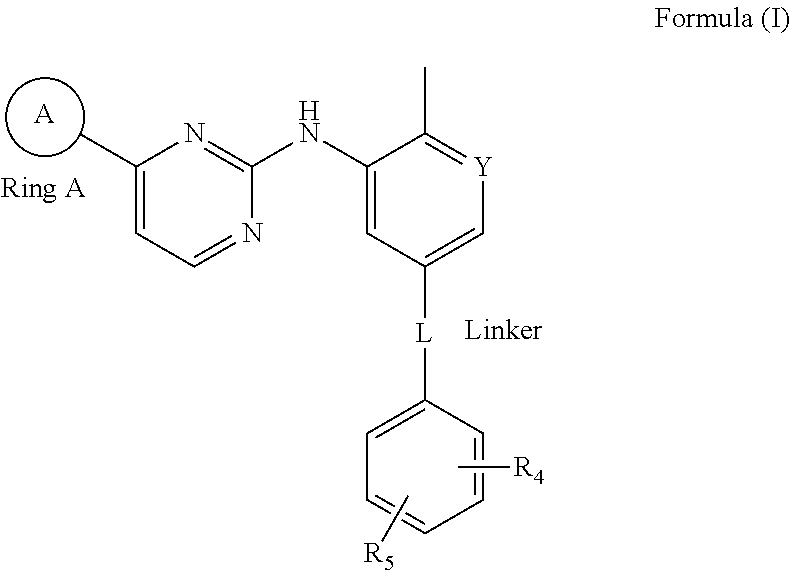Compounds for Treating Neurodegenerative Diseases and Cancers
- Summary
- Abstract
- Description
- Claims
- Application Information
AI Technical Summary
Benefits of technology
Problems solved by technology
Method used
Image
Examples
example 1
dimethylamino)propyl)phenyl)-4-methyl-3-((2-(pyridin-3-yl)pyrimidin-4-yl)amino)benzamide
[0146]
Step 1: Dimethyl-[1-methyl-2-(4-nitro-phenyl)-ethyl]-amine
[0147]To a solution of 1-(4-Nitro-phenyl)-propan-2-one (0.7 g, 4 mmol) in 100 mL of CH2Cl2 was added Dimethylamine in MeOH (1M, 6 mL) under nitrogen protection at room temperature, stirred for 30 min, then NaBH(OAc)3 (1.5 g) portion wisely in 3 hours. The reaction mixture was stirred at room temperature for overnight and quenched with water. The separated aqueous layer was neutralized with 4N of aq. NaOH to pH=8-9 and extracted with CH2Cl2. The organic layer was dried by Na2SO4, concentered. The residue was slurried in MTBE and 4N HCl in dioxane (5 mL) was added. Precipitates were collected by filtration to give Dimethyl-[1-methyl-2-(4-nitro-phenyl)-ethyl]-amine (HCl slat) as off-white solids (0.8 g, 81%).
Step 2: 4-(2-Dimethylamino-propyl)-phenylamine
[0148]To a solution of Dimethyl-[1-methyl-2-(4-nitro-phenyl)-ethyl]-amine (0.8 g) in...
example 2
N-(4-(1-methylpiperidin-4-yl)phenyl)-3-((2-(pyridin-3-yl)pyrimidin-4-yl)amino)benzamide
[0150]
[0151]To a suspension of 3-(2-Pyridin-3-yl-pyrimidin-4-ylamino)-benzoic acid (0.7 g) in 100 mL of DMF at 0° C. was added 4-(1-Methyl-piperidin-4-yl)-phenylamine (0.6 g), HATU (0.9 g), and DIPEA (1.3 mL). The reaction mixture was stirred at room temperature overnight before pure into ice water. The slurry was stirred at room temperature, filtrated, and washed with MTBE to get Compound 2 as pale brown solids (1.1 g, 81%). MS: [M+H]+: 479.2; HPLC purity: 97.9%.
example 3
Levels of Aβ40 and A1342
[0152]Aβ40 and Aβ42 peptides are the main building blocks for the formation of toxic AP. Inhibiting production of Aβ40 and Aβ42 and / or increasing clearance of Aβ40 and Aβ42 are the important strategies of drug development for the treatment of AD. The developmental γ-secretase inhibitors, BACE inhibitors and AP antibodies belong to this category. Anti-cancer drugs Imatinib and Nilotinib are found to be able to decrease AP and tau aggregate, two pathogenic hallmarks of AD. Imatinib and Nilotinib lower the levels of Aβ40 and Aβ42 by inhibiting production of Aβ40 and Aβ42 as well as mediate autophagy degradation pathways. Due to their limited brain permeability and mild potency, more potent Imatinib and Nilotinib analogs with improved brain penetration were developed and disclosed herein. For example, in the ELISA assay, Imatinib analog 1 is more potent than Imatinib on reducing Aβ40 and Aβ42 levels (FIGS. 1 and 2). These Imatinib analogs also showed in vivo effi...
PUM
 Login to View More
Login to View More Abstract
Description
Claims
Application Information
 Login to View More
Login to View More - R&D
- Intellectual Property
- Life Sciences
- Materials
- Tech Scout
- Unparalleled Data Quality
- Higher Quality Content
- 60% Fewer Hallucinations
Browse by: Latest US Patents, China's latest patents, Technical Efficacy Thesaurus, Application Domain, Technology Topic, Popular Technical Reports.
© 2025 PatSnap. All rights reserved.Legal|Privacy policy|Modern Slavery Act Transparency Statement|Sitemap|About US| Contact US: help@patsnap.com



